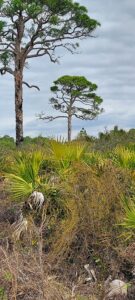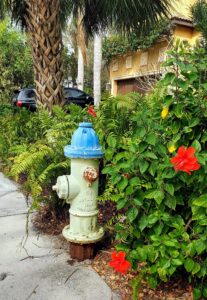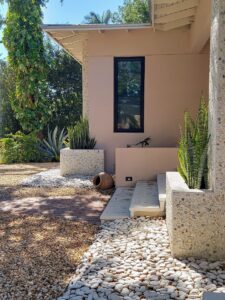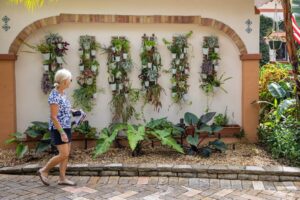Firescaping: Keep your Home Safe while Enjoying your Yard and Garden!

Firescaping can be seen as an aspect of landscaping and yard design which enhances the safety of your home through all seasons! This concept goes hand-in-hand with hurricane preparedness and

sound horticultural practices. When you follow some of the landscaping tips in this article you will be ready for both the dry winter and spring months as well as the rainy season!
Florida experiences a year-round wildfire risk, but the peak wildfire season generally occurs from April through June. However, the dry season from late October through April can also be a time of increased wildfire activity. This is because Florida’s rainy season typically begins in May, and a slow start to the rainy season can exacerbate fire conditions.
Dry conditions, wind, drought, human activity, deforestation and urbanization can lead to an exacerbation of fire activity. Arson, lightning, and debris burning add to the fire hazard. The growing number of people living in communities built in areas that were once wildland spaces increase pressure on the state’s wildland firefighters. The city of Sarasota abuts to the shore, is within the Phillipi Creek tributary zone and houses Hudson’s Bayou. Bayview Heights Neighborhood in the heart of Southside Village, just 5 minutes from center city-Sarasota, has a forever wild area which is often overlooked by city maintenance crews! Despite our proximity to downtown we still have vacant and jungle like lots in our midst! Lemon Street traversing the entire downtown area has a wild-untamed jungle across from the railway tracks! Never cleaned or touched it is a fire hazard in the heart of downtown !
As a result of this growth, fire protection becomes everyone’s responsibility.
Firescaping emphasizes the use of plants with low combustibility and high moisture content. Native species adapted to the local environment are often preferred, as they tend to be more resilient. Examples include succulents, deciduous trees, and certain ground covers that are less prone to ignition. An entire yard of mulch, and/or stone or synthetic grass not only increase the heat on your property but can result in desiccation of your plantings. Lest we forget- higher utility bills can be seen!
The amount of water in a leaf makes the shrub more fire resistant! Most plants are 50% water-Plants with thick, succulent leaves, such as cacti, aloe, and century plants, generally maintain high leaf moisture content, even during droughts, and thus have low flammability.
The size and shape of leaves suggest levels of flammability. Small, needle-like leaves, like those on pines and cedars, are generally more flammable than wider, flat leaves, such as those on maples, oaks, and hickories.
The presence of oils, resins, waxes, or other chemicals in leaves or branches increases flammability. Try to avoid highly flammable plants like saw palmetto, wax myrtle, and Yaupon Holly. Downy rose myrtle, old world climbing fern, cogon grass and eucalyptus can be invasive as well as flammable. Saw Palmetto and Yaupon Holly are wonderful…can’t deny yourself…keep as far from your home as possible!
With close lot lines, FPL high voltage wires on the ROAs use the concepts of CLEAN, GREEN AND LEAN as well as “Right Plant in the Right Place” to help you plan your landscaping for both hurricane and fire safety! Firewise trees include: Ash, Crape Myrtle, Dogwood, Jacaranda, Loquat, Oaks, Black cherry, Sparkleberry, Hophornbeam, Pecan and Willow. Basswood, Silver Buttonwood, Gumbo Limbo, Red Bay, Green Buttonwood, Mahogany, Sweet Acacia, Pigeon Plum, Hawthorne, elm, Magnolia, Maple, Redbud and Sycamore add to the mix! Remember-want a new tree? Please research the size and growth pattern of the tree in question…small lot…small tree!
Keeping Palms far from power lines is essential. Vie for smaller multi-stemmed varieties and bushes for screening. Pindo Palm, Queen Palm, Alexander Palm, Pygmy Date Palm, Sago and King Sago are all considered fire-resistant. Think agave, oleander, azalea, philodendron, camellia, Indian Hawthorne, beautyberry, viburnum, and coontie. These bushes are small and controllable.
No matter what you plant the concept of Lean, Clean and Green is the key to yard safety! Space your shrubbery according to planting guidelines (no matter what your landscaper says!) Keep them under control, and make sure your shrubs and trees are watered when needed! Trim large trees to provide an open canopy; work towards creating an area of

defensible space- crucial for protecting your home. It is safest to plant at least five feet from your home….and less- flammable ground covers are best…stone or green ground cover is optimal. Once you move out five to ten feet well maintained and healthy plantings will offer a safer yard.
Don’t forget the outside kitchen and b- b- que area as well as the fire pit! A fire extinguisher rated A-B-C and a fire blanket should be on hand! Take a look; is your house number easily visible from the street? EMT, police and fire departments often loose precious time if they cannot be sure of the house number!
Take a walk-about your property and rate your yard – is it “fire-wise”? …..Lean, Clean and Green-you win! Too much jungle? Take out the machete and gardening gloves….
Karen Pariser
Complete Streets
Master Gardener Volunteer
Synopsis of Firescaping Presentation
May 8, 2025
